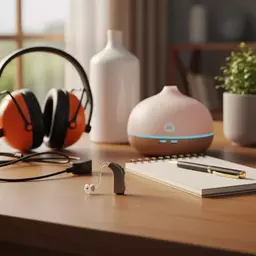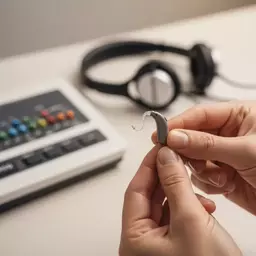Did you know that a well-fitted hearing aid can dramatically change how you interact with the world around you? Choosing the right device is not just about amplification; it’s about regaining confidence and enhancing your quality of life.
What You Will Learn
- The importance of hearing health and its impact on communication and social interaction.
- How to recognize your personal needs based on your lifestyle and social preferences.
- A step-by-step guide to choosing the right hearing aid, including scheduling a hearing test and consulting with an audiologist.
- Essential features to consider, such as noise reduction, Bluetooth connectivity, and battery life.
- Insight into the various types of hearing aids available and their unique benefits.
- Key factors to evaluate costs, insurance coverage, and financing options for hearing aids.
- The significance of trial periods and aftercare to ensure your hearing aid meets your expectations.
Step-by-Step Process to Choose the Right Hearing Aid
This visual outlines the crucial steps towards selecting and maintaining your ideal hearing aid, emphasizing a systematic approach for optimal results.
Step 1 & 2Schedule & Consult with Audiologist
Begin with a professional hearing test to identify specific needs, followed by expert guidance from an audiologist for tailored recommendations.
Step 3 & 4Explore Types & Evaluate Features
Discover various hearing aid styles (BTE, ITE, RIC) and assess key features like noise reduction, Bluetooth, and battery life for your lifestyle.
Step 5 & 6Assess Costs & Utilize Trial Period
Understand pricing and insurance options, then use a trial period to ensure the chosen device meets your expectations in real-life settings.
Step 7Aftercare & Maintenance
Learn essential cleaning and maintenance tips to ensure the longevity and optimal performance of your hearing aid, and troubleshoot common issues.
A Comprehensive Guide to Selecting Your Ideal Hearing Aid
Hearing loss can significantly impact daily life, affecting everything from conversations with loved ones to enjoying your favorite music. It's vital to choose the right hearing aid to enhance your hearing experience and maintain those important connections. At HearWise Living, we understand the challenges you may face and aim to empower you to make informed decisions about your hearing health!
Choosing the right hearing aid is not just about amplifying sound; it’s about regaining your confidence and improving your overall quality of life. A well-fitted hearing aid can dramatically change how you interact with the world around you, making everyday activities feel more enjoyable and fulfilling.
Understanding the Importance of Hearing Health

Maintaining good hearing health is crucial for effective communication and social engagement. Did you know that untreated hearing loss can lead to feelings of isolation and frustration? Selecting the right hearing aid plays a significant role in combating these challenges and enhancing your social interactions. For more insights on how hearing affects overall well-being, explore our article on Hearing Loss and Mental Health.
- Improved Communication: Hearing aids can help you participate fully in conversations.
- Enhanced Quality of Life: Listen to music, watch television, or engage in group discussions without the strain.
- Tackling Social Isolation: Stay connected with friends and family, reducing the risk of loneliness.
Understanding the profound impact of hearing health on your life is crucial. By prioritizing this aspect, you're taking a significant step toward a more connected and fulfilling existence!
Recognizing Your Personal Needs
When it comes to choosing a hearing aid, your personal lifestyle and preferences are essential in the decision-making process. Ask yourself: What environments do you spend the most time in? Do you enjoy socializing, or do you prefer quiet moments? These factors heavily influence which hearing aids will work best for you.
- Active Lifestyle: If you’re frequently in bustling environments, look for hearing aids with excellent noise reduction features.
- Social Preferences: For those who love gatherings, consider models that offer Bluetooth connectivity for seamless streaming.
- Hearing Needs: Think about your specific challenges—are you struggling to hear in crowded spaces or during phone calls?
Recognizing your individual needs makes the selection process much smoother, ensuring that your hearing aid complements your lifestyle and enhances your everyday experiences!
Step-by-Step Process to Choose the Right Hearing Aid
Step 1: Schedule a Hearing Test with an Audiologist
The first step in finding your ideal hearing aid is to schedule a hearing test with an audiologist. This test will help identify your specific hearing loss and what level of assistance you need. During the test, you can expect a series of sound levels and pitches, helping to paint a clear picture of your hearing abilities.
Understanding your unique hearing profile is essential for selecting a device that meets your needs. Plus, it gives you a baseline to track improvements over time!
Step 2: Consult with an Audiologist for Expert Guidance
After your hearing test, consulting with an audiologist is crucial. These professionals are trained to provide expert advice on the best hearing aids for your situation. They can guide you through the different options available and help you understand the features you might need.
- Custom Recommendations: Audiologists can suggest hearing aids tailored to your specific hearing loss.
- Understanding Technology: They will explain how different features can enhance your listening experience.
- Support and Counseling: Your audiologist can also provide emotional support as you navigate this journey.
With their guidance, you’ll feel much more confident in your decision-making process!
Step 3: Explore Different Types of Hearing Aids
Understanding Hearing Aid Types: BTE, ITE, RIC and More
Now that you’ve consulted with your audiologist, it’s time to explore the different types of hearing aids available. There are several styles to choose from, including:
- BTE (Behind-The-Ear): These are worn behind the ear and are suitable for a wide range of hearing losses.
- ITE (In-The-Ear): Custom-fitted to the shape of your ear, these are generally more discreet.
- RIC (Receiver-In-Canal): Offers a natural sound experience and is less visible than BTEs.
Choosing the right type is essential for comfort and effectiveness. Each style has its unique advantages, so discussing these options with your audiologist is critical!
Step 4: Evaluate Essential Hearing Aid Features
Key Features to Consider: Noise Reduction, Bluetooth Connectivity, and Battery Life
When selecting a hearing aid, consider the features that will best enhance your listening experience. Some essential features to explore include:
- Noise Reduction: This feature helps minimize background noise, making conversations clearer.
- Bluetooth Connectivity: Connect your hearing aids to smartphones or other devices for better audio experiences.
- Battery Life: Consider whether you prefer rechargeable batteries or standard ones.
These features can dramatically influence how you interact with your surroundings, making your hearing aid experience more enjoyable and functional!
Step 5: Assess Costs and Insurance Coverage Options

Navigating Hearing Aid Costs and Financing Options
Understanding the costs associated with hearing aids is vital. Prices can vary widely based on the technology and features you choose, so it’s essential to do your research. Additionally, many insurance policies offer varying levels of coverage, so check with your provider!
- Price Ranges: Hearing aids can range from several hundred to several thousand dollars.
- Financing Options: Many providers offer financing plans to help manage costs.
- Warranties: Look into warranties to ensure protection against defects and malfunctions.
Being financially prepared ensures you can find a hearing aid that fits your budget while still meeting your hearing needs!
Step 6: The Importance of a Trial Period
Once you’ve selected a hearing aid, it’s crucial to take advantage of the trial period offered by most audiology practices. This allows you to experience the device in real-life situations, ensuring it meets your expectations. Pay attention to how it feels and fits in various environments.
Ask about return policies as well—this knowledge will give you peace of mind as you adjust to your new hearing aid!
Step 7: Aftercare and Maintenance of Your Hearing Aid
Essential Cleaning and Maintenance Tips for Longevity
To keep your hearing aids in optimal condition, regular maintenance is key! Here are some practical tips:
- Daily Cleaning: Wipe down your hearing aids regularly with a soft, dry cloth.
- Battery Care: Replace batteries as needed and keep them stored properly.
- Earwax Management: Regularly check for earwax build-up that may affect performance.
With proper care, your hearing aids can last longer and perform better, ensuring you enjoy clear sound for years to come!
Troubleshooting Common Hearing Aid Issues
Even with the best care, you may encounter some common issues. Here are a few solutions for troubleshooting:
- Sound Quality Issues: Check for battery life and clean the device to remove any debris.
- Feedback Sounds: Adjust the fit to ensure a proper seal in your ear canal.
- Connectivity Problems: Ensure Bluetooth is enabled and check device compatibility.
Remember, reaching out to your audiologist for support is always a good idea. They can offer professional assistance and ensure your hearing aids are functioning at their best!
Pro Tip
When selecting a hearing aid, consider opting for models equipped with Bluetooth connectivity. This feature not only allows you to stream audio directly from your smartphone but also simplifies phone calls and video chats, making communication clearer and more enjoyable. Embracing technology can significantly enhance your overall hearing experience!
Frequently Asked Questions (FAQs)
Q: Why is choosing the right hearing aid important?
A: Choosing the right hearing aid is crucial for regaining confidence, improving overall quality of life, enhancing communication, and maintaining social engagement. A well-fitted device can significantly change how you interact with the world.
Q: What is the first step in selecting a hearing aid?
A: The first step is to schedule a professional hearing test with an audiologist. This test identifies your specific hearing loss and helps determine the level of assistance you need.
Q: What are the main types of hearing aids available?
A: The main types include BTE (Behind-The-Ear), ITE (In-The-Ear), and RIC (Receiver-In-Canal). Each style offers unique advantages in terms of comfort, discretion, and suitability for different hearing loss levels.
Q: What key features should I look for in a hearing aid?
A: Essential features to consider include noise reduction (to minimize background noise), Bluetooth connectivity (for streaming audio and calls), and battery life (rechargeable vs. standard batteries).
Q: Is a trial period for a hearing aid important?
A: Yes, a trial period is crucial. It allows you to test the device in real-life situations to ensure it meets your expectations for comfort, effectiveness, and fit before making a final commitment.
Q: How can I maintain my hearing aid for longevity?
A: Regular maintenance includes daily cleaning with a soft, dry cloth, proper battery care, and routinely checking for and removing earwax build-up. These practices ensure optimal performance and extend the life of your device.
Summarizing Your Journey to Finding the Right Hearing Aid
Choosing the right hearing aid can feel like a daunting task, but with the right knowledge and support, you can find a device that truly meets your needs. As we wrap up this guide, let's recap the essential steps in your journey to selecting and caring for your hearing aid:
- Schedule a comprehensive hearing test with an audiologist.
- Consult with your audiologist for tailored guidance and recommendations.
- Explore the various types of hearing aids available, from BTE to ITE.
- Evaluate key features that enhance your hearing experience.
- Assess the costs and available insurance options for financing.
- Take advantage of the trial period to ensure the best fit.
- Prioritize aftercare and maintenance for longevity.
Each step plays a vital role in ensuring you select a hearing aid that not only fits your lifestyle but also enhances your overall hearing health. Remember, it’s not just about finding a device; it’s about embracing a new way to engage with the world around you!
Encouraging Next Steps and Professional Consultation
Now that you're equipped with the knowledge to choose the right hearing aid, I encourage you to take the next step! Booking a consultation with an audiologist can provide you with personalized insights and recommendations that align with your specific needs. At HearWise Living, we believe in empowering you through accessible knowledge and supportive resources. For more detailed guidance on choosing a specialist, refer to our guide on selecting the right audiologist.
To help you on your journey, here are some useful resources and checklists:
- Hearing Aid Selection Checklist: A handy guide to keep track of your needs and preferences.
- Questions to Ask Your Audiologist: Ensure you get all the information you need during your consultation.
- Guide to Understanding Hearing Aid Features: A deeper dive into what features might suit your lifestyle best.
Don’t hesitate to reach out to us at HearWise Living for further assistance or questions you may have. Remember, the path to better hearing starts with taking that first step, and you’re not alone on this journey!
Recap of Key Points
Here is a quick recap of the important points discussed in the article:
- Schedule a comprehensive hearing test with an audiologist.
- Consult with your audiologist for tailored guidance and recommendations.
- Explore the various types of hearing aids available, from BTE to ITE.
- Evaluate key features that enhance your hearing experience.
- Assess the costs and available insurance options for financing.
- Take advantage of the trial period to ensure the best fit.
- Prioritize aftercare and maintenance for longevity.









